Home > Product Installs & Reviews > Product Reviews > Car Amplifier Reviews > Fusion Signature Series Amplifiers: First Look Review
In this article: We'll take a first look at Fusion's Signature Series amplifiers, walk you through their key features and provide you with our honest opinion and review along the way.
A lot of people undervalue the importance of a well-matched amplifier (or amplifiers) in their boat. I commonly see installers using a combination of the head unit and amplifiers to power the speakers in boats, join two pairs of speakers on one channel, and even flat out not hook up speakers to the amplifier altogether! Most of the time these scenarios are a result of cheap work, or cheap boat owners trying to save a few bucks. Amplifiers are the most common bottlenecks of the stereos that I've seen in boats, even with a killer speaker and subwoofer setup.
Don't overlook your amplifiers when you're building a stereo, whether it's for your boat or car. Make sure your amplifiers can meet the recommended power requirements and specs of the speakers that they're powering. And in the boat world, ensure that the marine amplifier that you purchase is designed and engineered to withstand the elements. Failure to do either of these two will result in either failure of your system at some point, or an underperforming stereo.
I start this review by prefacing these things because when I first saw the lineup of Signature Series amplifiers from Fusion along with their specs I immediately thought about how easily I could match up an entire system on our Axis A22 wakeboard boat. And I could do it without bridging, MacGyvering, or leveraging an underpowered head unit output for the high performance Signature Series 3 tower speakers and Signature Series 3 interior speakers that I planned on putting into this boat. In fact, I was really pleased to see that I could very adequately power the (pretty standard setup of) 6 interior speakers, 2 tower speakers and 12″ subwoofer with only two amplifiers – an 8-channel and a monoblock. This was my choice for this system but their lineup of 8, 6, 5, 4 and monoblock amplifiers really give you a ton of options to power a variety of configurations on a wakeboard boat or any other boat.
The Signature Series Amplifiers were originally announced in February of 2019, and in this review I'll open up the box to an 8-channel and monoblock and give you an inside look at the amps along with all of their features. Please note that this is a First Look review only and we don't touch on the actual performance or sound of these amplifiers in a real setting yet. Please check back for when we install it in our Axis A22 to see what we think about it's performance.
About Fusion
For those of you who may not know, Fusion is now a Garmin brand. In 2014, Garmin announced the acquisition of Fusion Electronics to add to its growing line of marine and automotive products. Fusion was founded in New Zealand in 1998 by Sir Peter Maire as a home grown car audio brand and grew to be a global audio brand. As Fusion grew, they entered into the marine world extending their established audio tech into the world of boats. With over two decades of engineering and designing automotive and marine electronics, Fusion's focus is quality and acoustic excellence.
Recent Reviews & Articles
Unboxing & First Impressions
I always like to dedicate a section to first impressions in my First Look reviews. It's the unboxing and first impression of a product that really dictates your experience with the product from thereon-out, isn't it? But even more important than that I like to answer questions like:
- What's in the box?
- Do they provide you with installation materials?
- How is the packaging and can the hardware damage the product in shipping?
- Was everything there?
- How does the product look and feel when you first look at it?
These are the things that you, as a reader, probably can't really do unless you have the product in your hand, so that's the purpose of this section.
So let's get started! The Signature Series amplifiers are packaged and presented as high-end, high-performing products and their packaging represents this. I've seen high-end stereo products come in terrible packaging, with manufacturers claiming that they instead put their marketing money into the quality of the products. But Fusion presents their products well in detailed packaging.
On the inside of the box, the hardware, materials and amplifier is securely packaged and I don't see any concerns that may lead to a damaged product in shipping. Here's a few photos of the box as we opened it up.
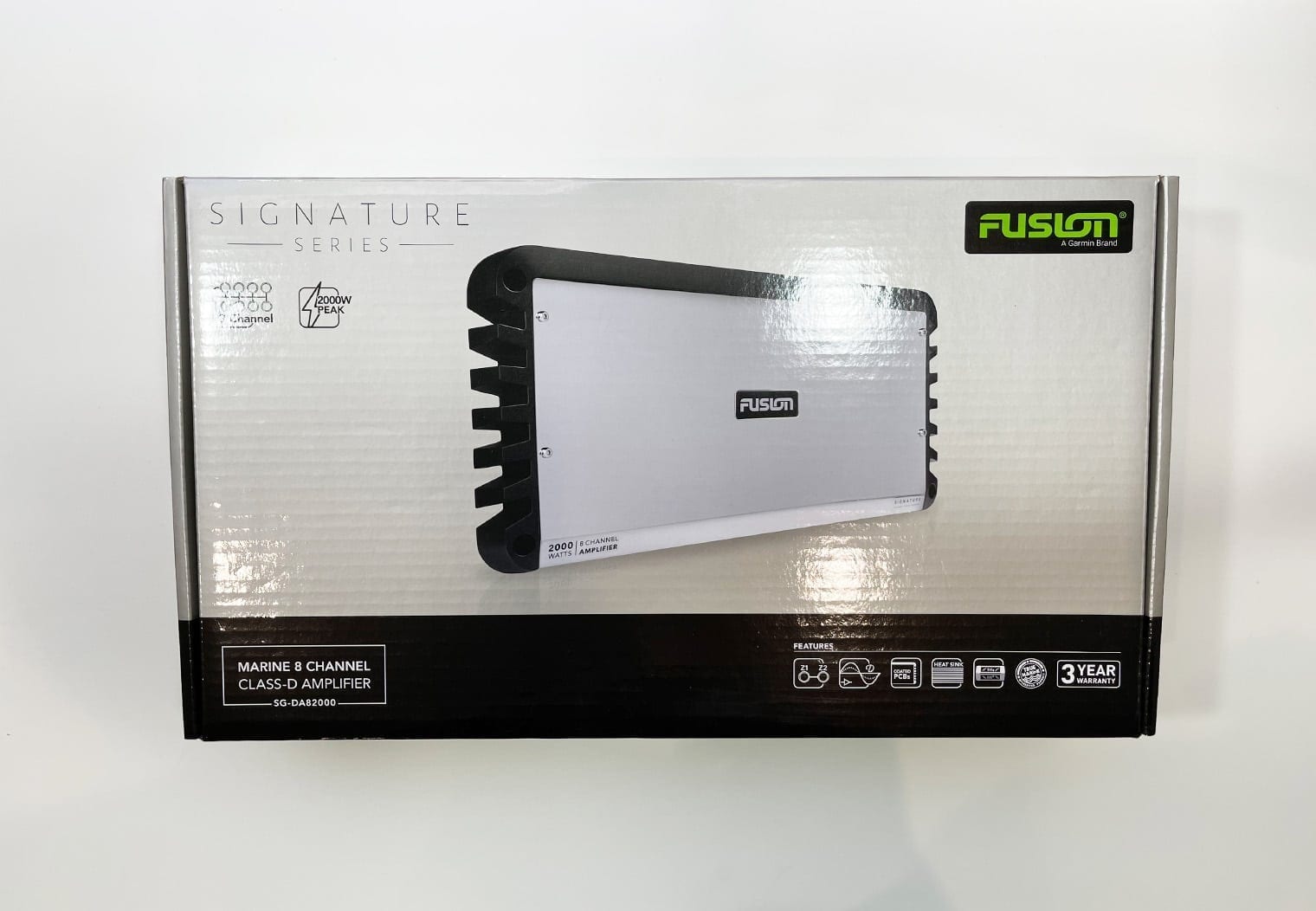
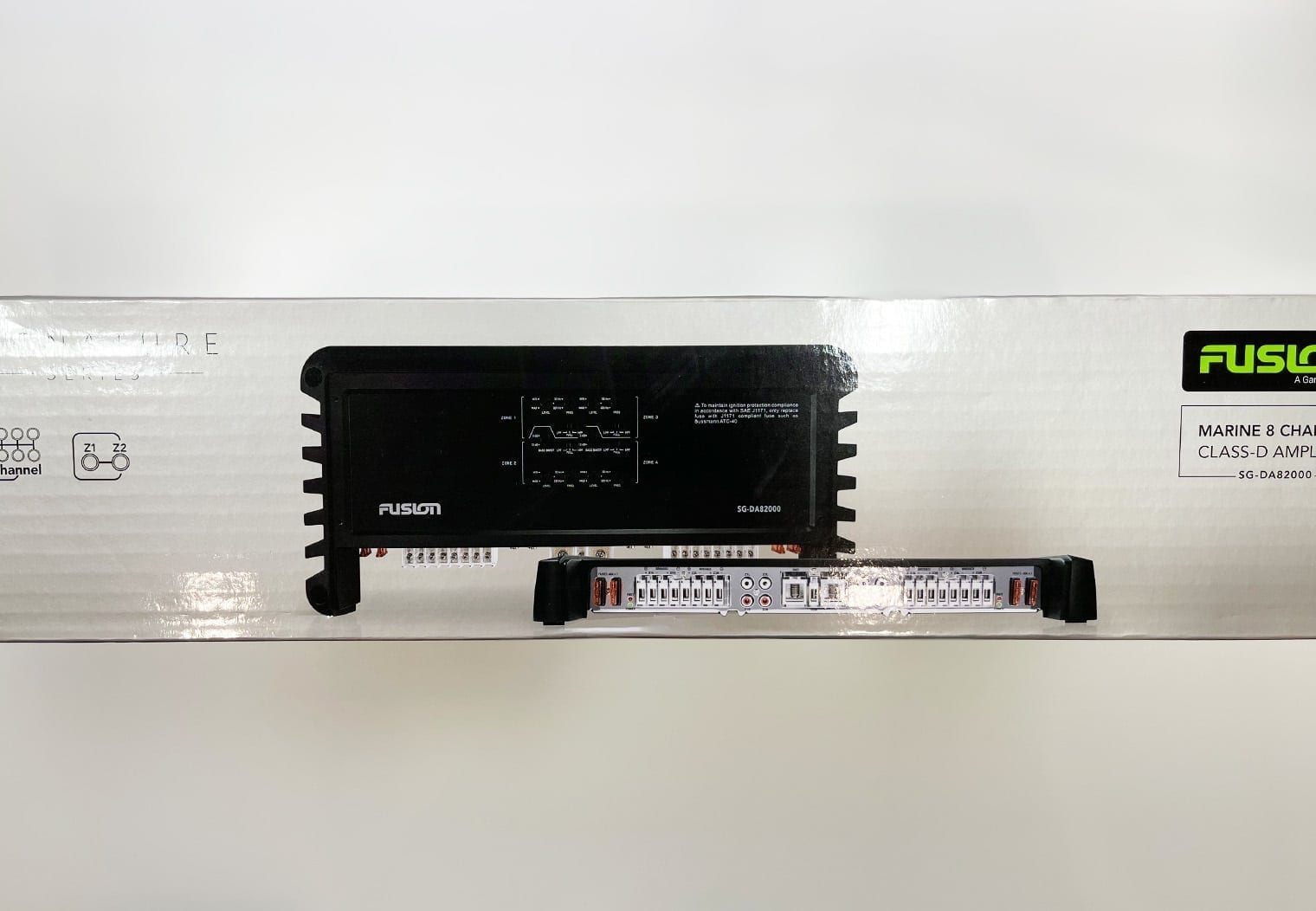
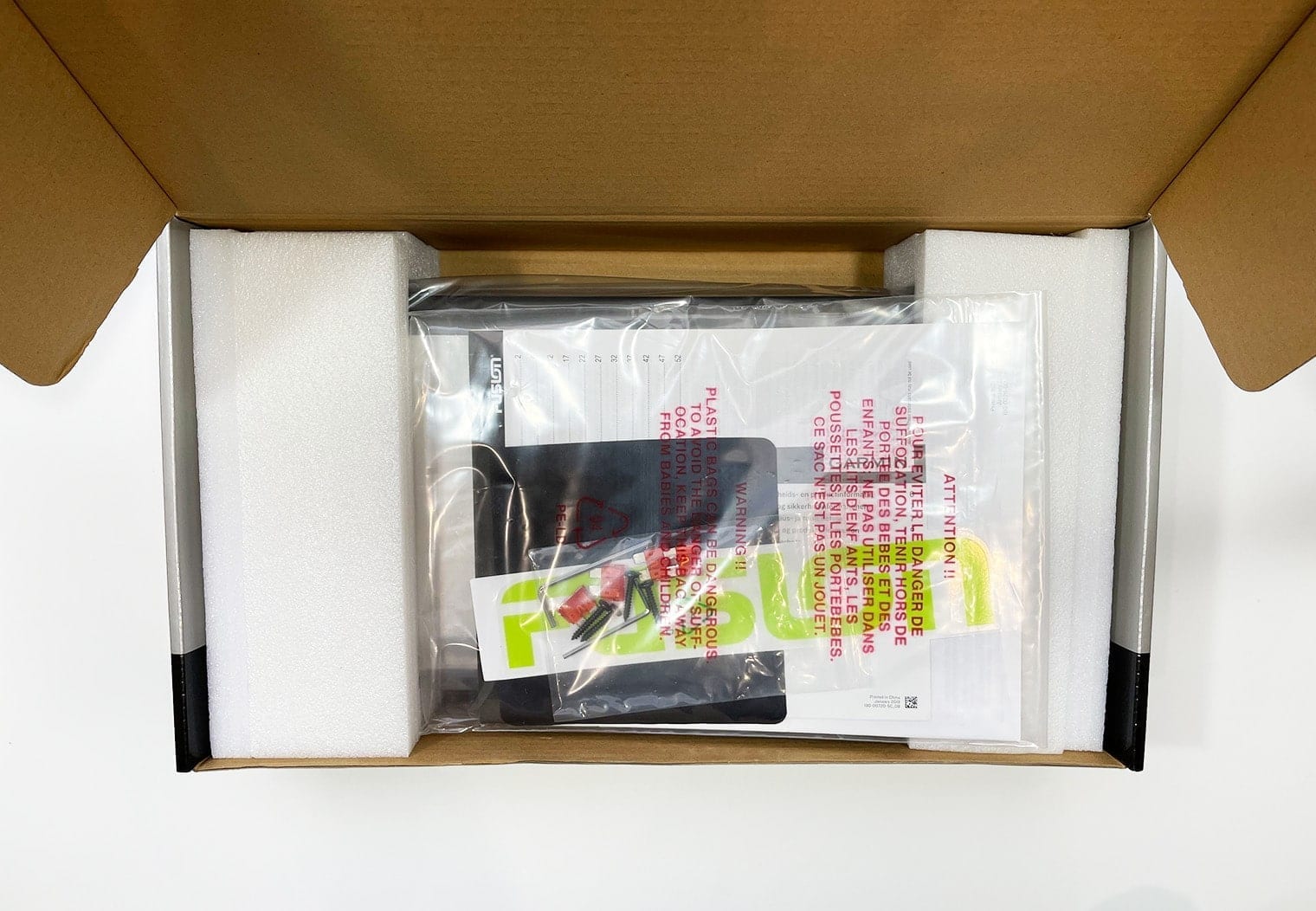
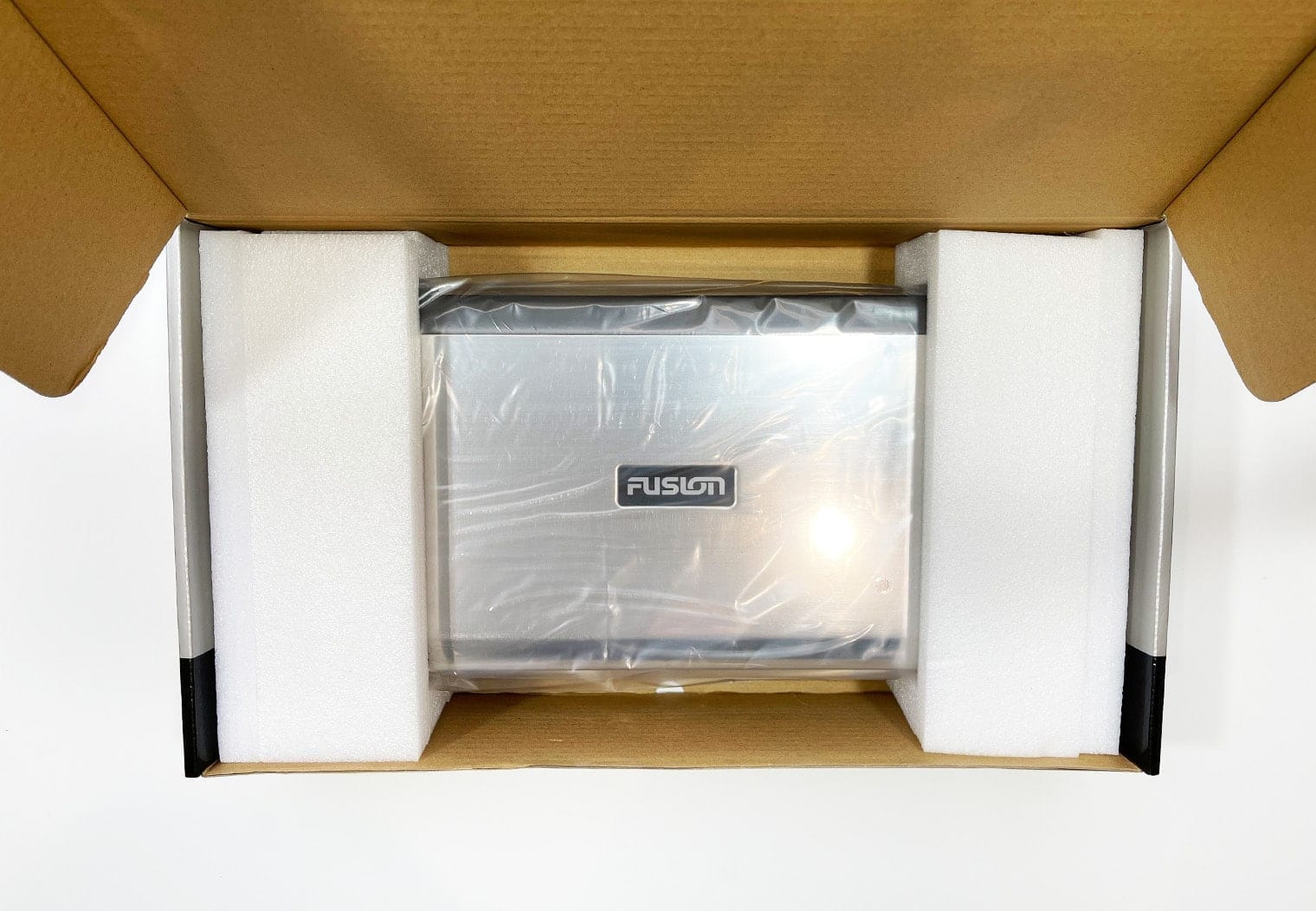
Once the amplifier is pulled from the box, you'll also notice an extra plastic film that wraps the amplifier and protects it from scratches and smudging during packaging and shipping. A nice added piece of protection that lets you know that Fusion cares about the presentation of their products when you open up the box. After this film is removed you're struck by a bright (if you're in a well lit area) and super reflective chrome finished amplifier. However, it's not actually chrome it's polished stainless steel! Upon initial inspection it looks well-sealed and equipped for the elements.
Some things that stood out to me when looking initially:
- The speaker terminals are well sealed and heavy duty as are the power inputs
- The underside of the amplifier is completely sealed up with a mounted metal plate
- The amplifier tuning adjustments are not sealed and the reflective stainless cover does not have any sealing material
What's In the Box (for the 8ch at least):
- Four 40-amp ATC fuses (installed)
- Four spare 40-amp ATC fuses
- Cleaning cloth (6″x6″)
- 2.5mm Allen wrench
- 3mm Allen wrench
- Four 1″ Screws
- Installation manual (English/ French/ Italian/ German/ Spanish/ Portuguese/ Dutch/ Danish/ Swedish)
- Safety information
- If you get a monoblock, it'll also come with a wired sub volume knob
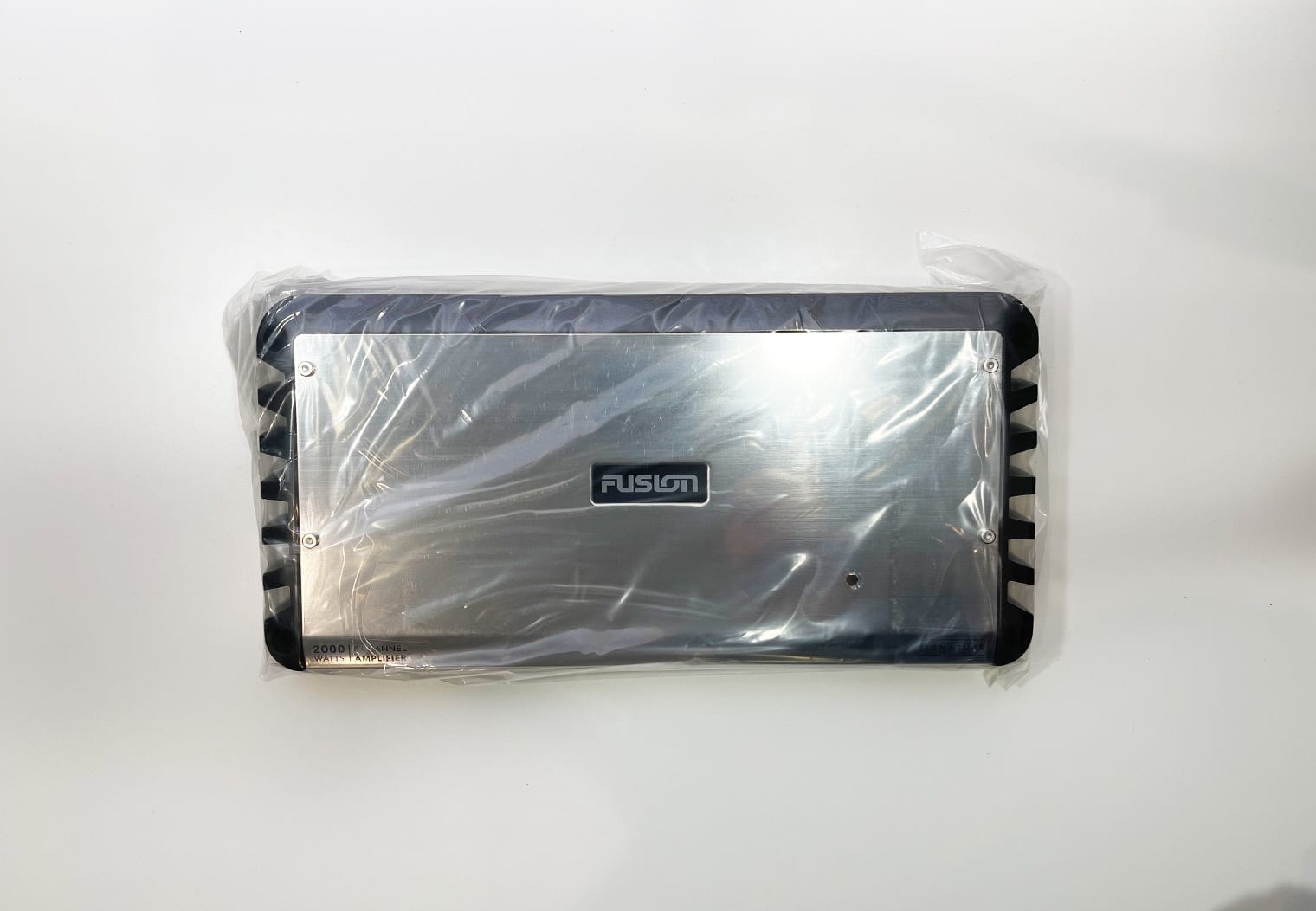

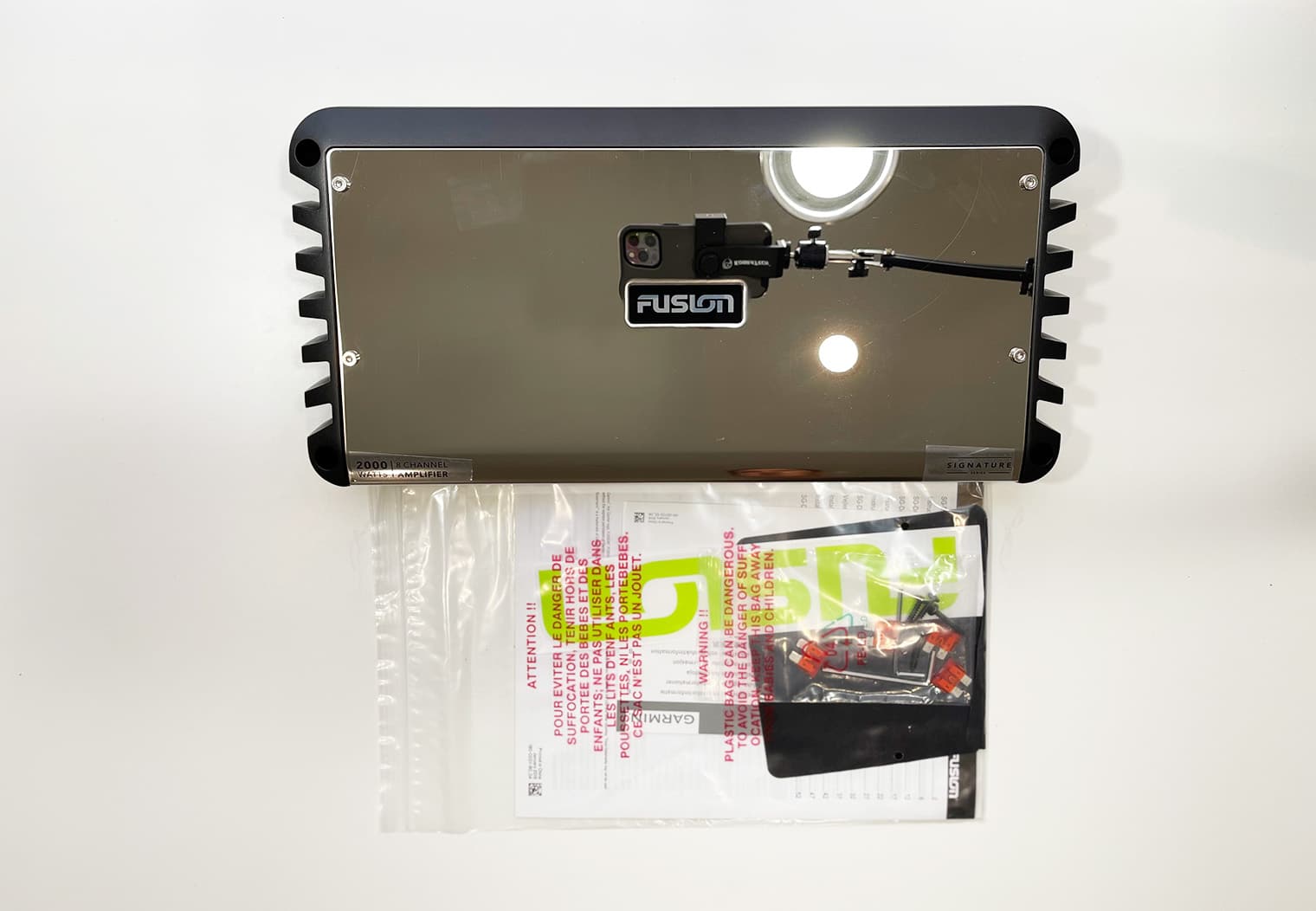
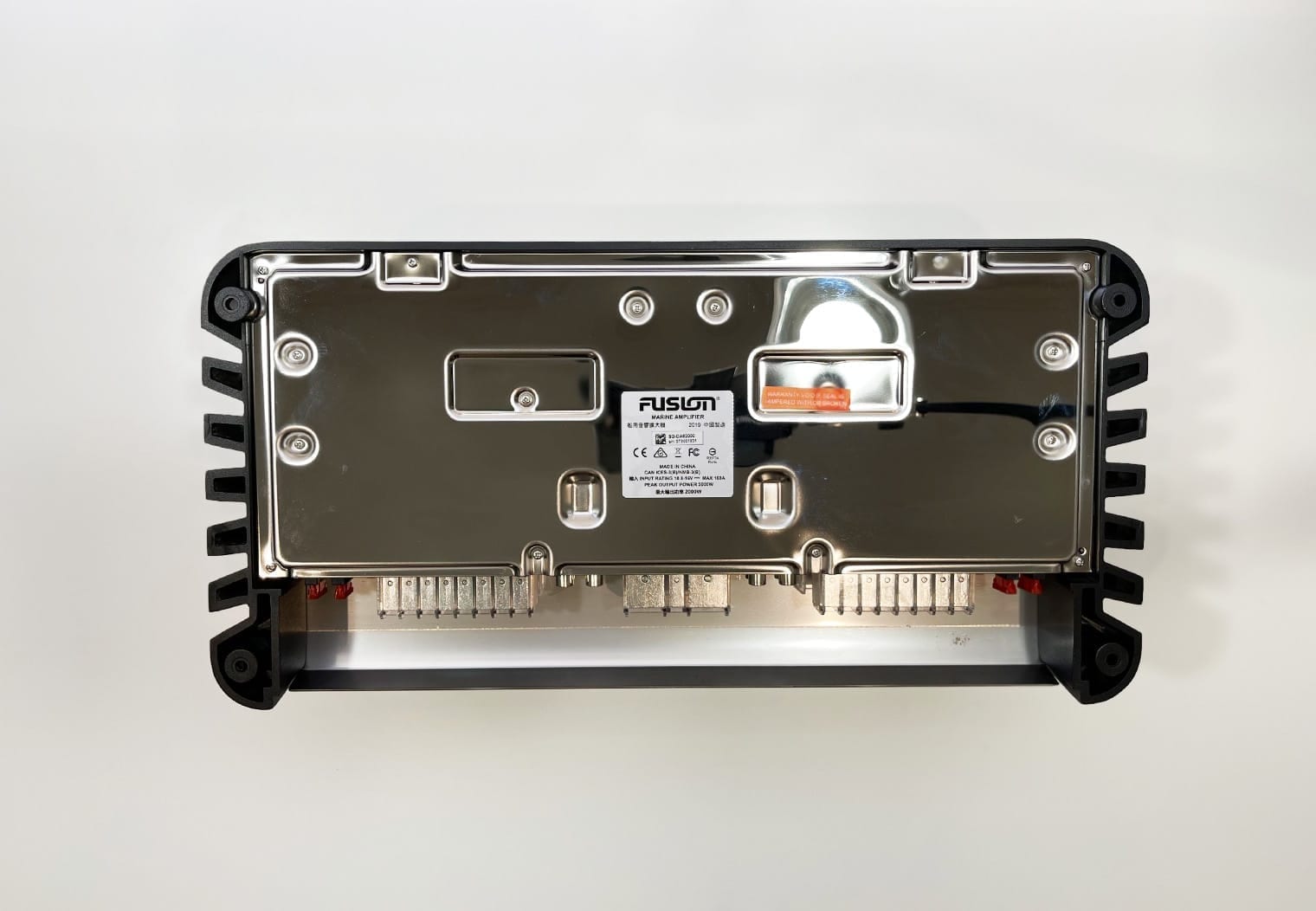
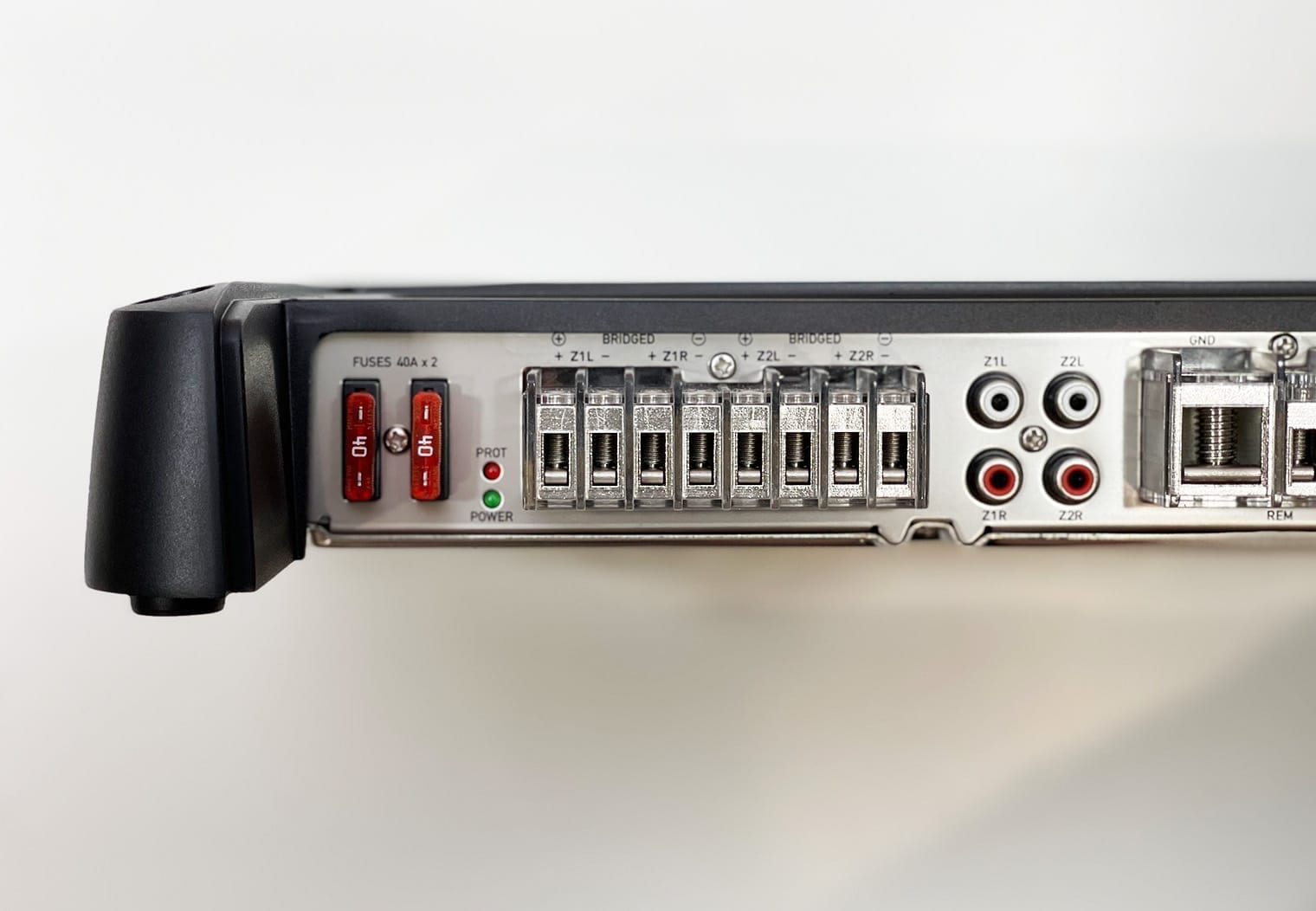
Amplifier Key Features: Configurations, Zones and Power
When I'm building a stereo for a boat, I look for the cleanest and most logical configuration of amplifiers and power I can find. Tying bow speakers to the head unit power output while using an amplifier for the center and stern interior speakers while using another channel for the towers – these are configurations that I loath. In many cases, I'll actually break away from using the same manufacturer amplifier as the speakers because power and configurations are limited. Or I'll change up the entire system, speakers and all, if I can't find a clean configuration that meets the specs of the speakers and subwoofers. Let's talk about the different types of configurations and power outputs that the Signature Series Amplifiers have.
Configurations
Fusion's Signature Series offers a variety of amplifiers that will give you a wide variety of configurations to power your system. They're engineered to match up well with their own Signature Series and Signature Series 3 speakers, but are powerful for any configuration or speaker setup. There are five amplifiers that you can choose from in Fusion's Signature Series lineup:
- SG-DA12250: Monoblock
- SG-DA41400: 4 Channel
- SG-DA51600: 5 Channel
- SG-DA61500: 6 Channel
- SG-DA82000: 8 Channel
What I like about this lineup is that they have a wide variety of channel options, all the way up to an 8 channel. With these options you can adequately power your system with limited bridging and with only one or two amplifiers, vs maybe a two to three amplifier option with the limited lineups from other manufacturers. And these amplifiers don't have low power outputs. I'll outline them more in the power section but these amplifiers were designed for power thirsty speakers like tower speakers and subwoofers so you'll really be able to get the most out of your system if you choose the right amps.
In our case, we chose the 8 channel and monoblock to power six interior speakers and two tower speakers along with a monoblock to power Fusion's Signature Series 3 Subwoofer. With these two amplifiers, we're putting out a total of 1970 Watts @ 2 ohms RMS (peak is 4250W). And it's a really clean configuration with a pair of speakers tied to a dedicated channel on the amplifier. Between the 5 different amp options, you'll most likely be able to do a similar setup and have a clean, well-powered system.
In terms of configurations directly on the amplifiers, the Signature Series is pretty standard. Meaning it has your typical high/low pass filters and gains along with bass boost for subwoofers. The one thing that I feel like it's missing in terms of configurations though is the ability to tie multiple zones/channels to a single RCA input. On the 8 channel amp that we're using, we are going to have to split RCAs two or three ways in order for every zone/channel to have signal. I wish they would have a selection for each zone that would allow you to choose which signal input the zone would use.
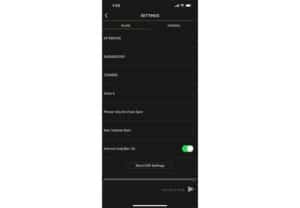
Zones
Zones and channels are kind of used interchangeably with Fusion's systems. The reason Fusion uses ‘Zones' instead of channels on their amplifiers is because they designed a series of products (speakers, subwoofers, head units) that work together. If you purchase one of their head units in addition to their amplifiers, like the MS-RA770, you'll see why. In the head unit, you'll see that you can customize, configure and align the zones directly with the zones on the amplifier. And even cooler, you can leverage Fusion's DSP feature to have a configured and tuned output to the amplifiers that's built by the Fusion engineers. With these DSP profiles, you no longer have to tune the amplifier either.
We have a dedicated zone for each pair of speakers and used Fusion's DSP profiles via the MS-RA770 head unit for each zones to tailor the output of the amplifier based on the speaker, amplifier power and the setting (e.g. indoor cabin vs open space on a wakeboard boat). When combined with Fusion's head unit and DSP profiles, zones become much more than a traditional channel on an amplifier and allow you to really optimize the output to your stereo with minimal effort.
Power
From a power perspective, I mentioned earlier that the Signature Series amplifiers are pretty high output. When I was in the process of choosing between a Wet Sounds system and JL Audio system for our Nautique G23 Stereo, power output was ultimately what determined which manufacturer I went with for the tower speakers, amplifiers and interior speakers. JL just didn't cut it for the configuration and power output that I was trying to build. I went with Wet Sounds because their amplifiers offered more power per channel and offered more flexibility for how I was going to wire and power each speaker. With the Signature Series amps, looking at the power outputs and channel (zone) configurations for each amp I can confidently say that you're going to be able to power the majority of speakers and setups very well. Here's a breakdown of each amplifier's power output at 2ohms to give you an idea:
- SG-DA12250: Monoblock
- 850 Watts RMS x 1 @ 14.4V – 2 Ohms 1% THD
- SG-DA41400: 4 Channel
- 220 Watts RMS x 4 @ 14.4V – 2 Ohms 1% THD
- SG-DA51600: 5 Channel
- 130 Watts RMS x 4 + 330 Watts RMS x 1 @ 14.4V – 2 Ohms 1% THD
- SG-DA61500: 6 Channel
- 140 W rms x 6 @ 14.4 V input < 1% THD + N (EIA/CEA-490A)
- SG-DA82000: 8 Channel
- 140 W rms x 8 @ 14.4 V input < 1% THD+N (EIA/CEA-490A)
If you want to read up more about bridging options for each amplifier you can click on the link for each amplifier to take you to a detail page. But in general these amplifiers are pretty high output. For example JL's M800/8v2 8 channel only has a 100 W output RMS x 8 (vs Fusion's 140 W x 8), or JL's M400/4 which only has 100 W x 4 (vs Fusion's 220 W x 4). And Wet Sounds doesn't even make an 8 channel amplifier. Just to name a few examples.
All-in-all, the combination of a variety of amplifier configurations (mono, 4, 5, 6 and 8 channel options) and high power output gives Fusion's Signature Series a very universal and configurable feel. If you would like our recommendations on an amplifier setup for your system feel free to comment at the bottom of the article!
Here's a few photos of the amplifier zones and tuning panels.
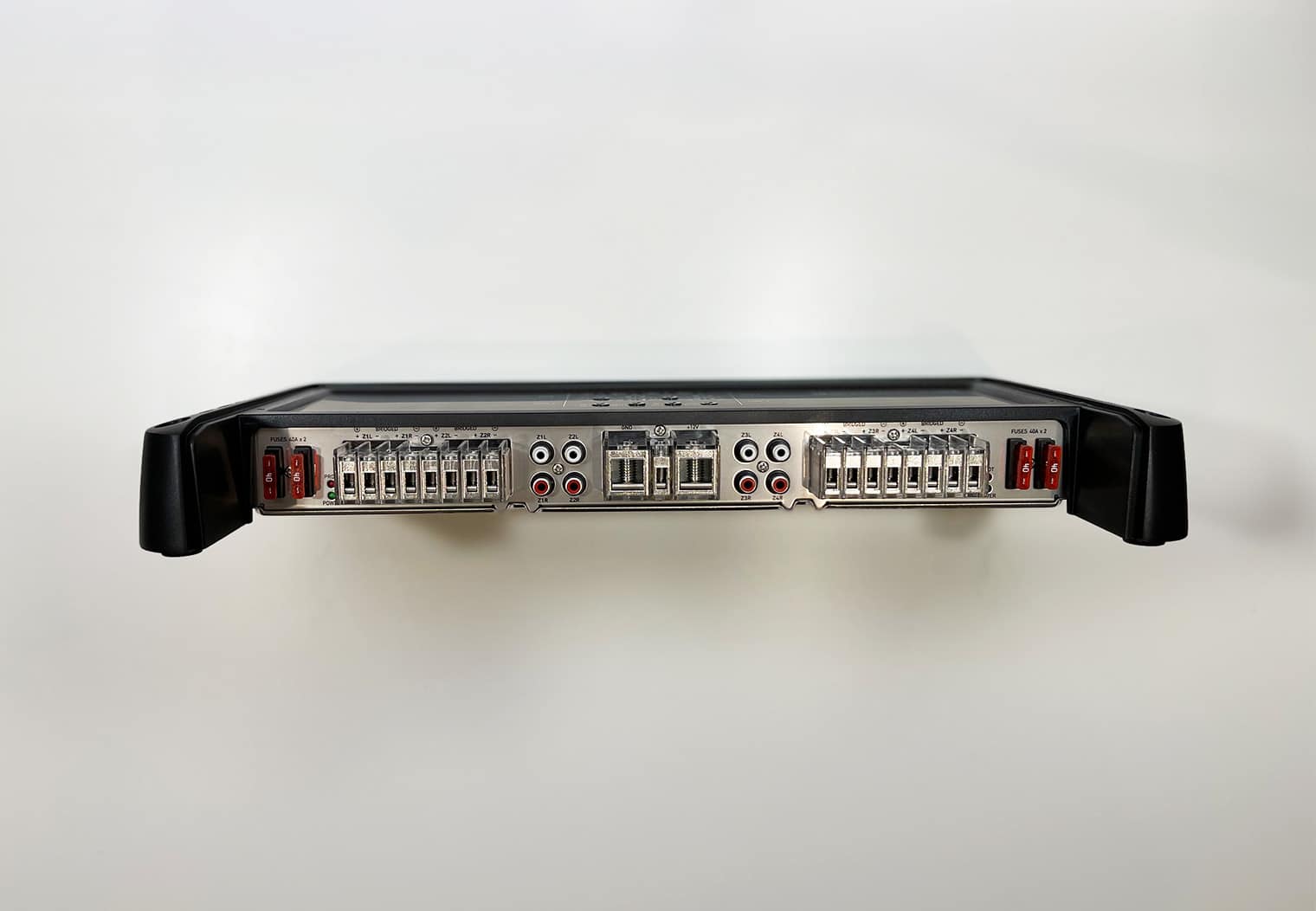
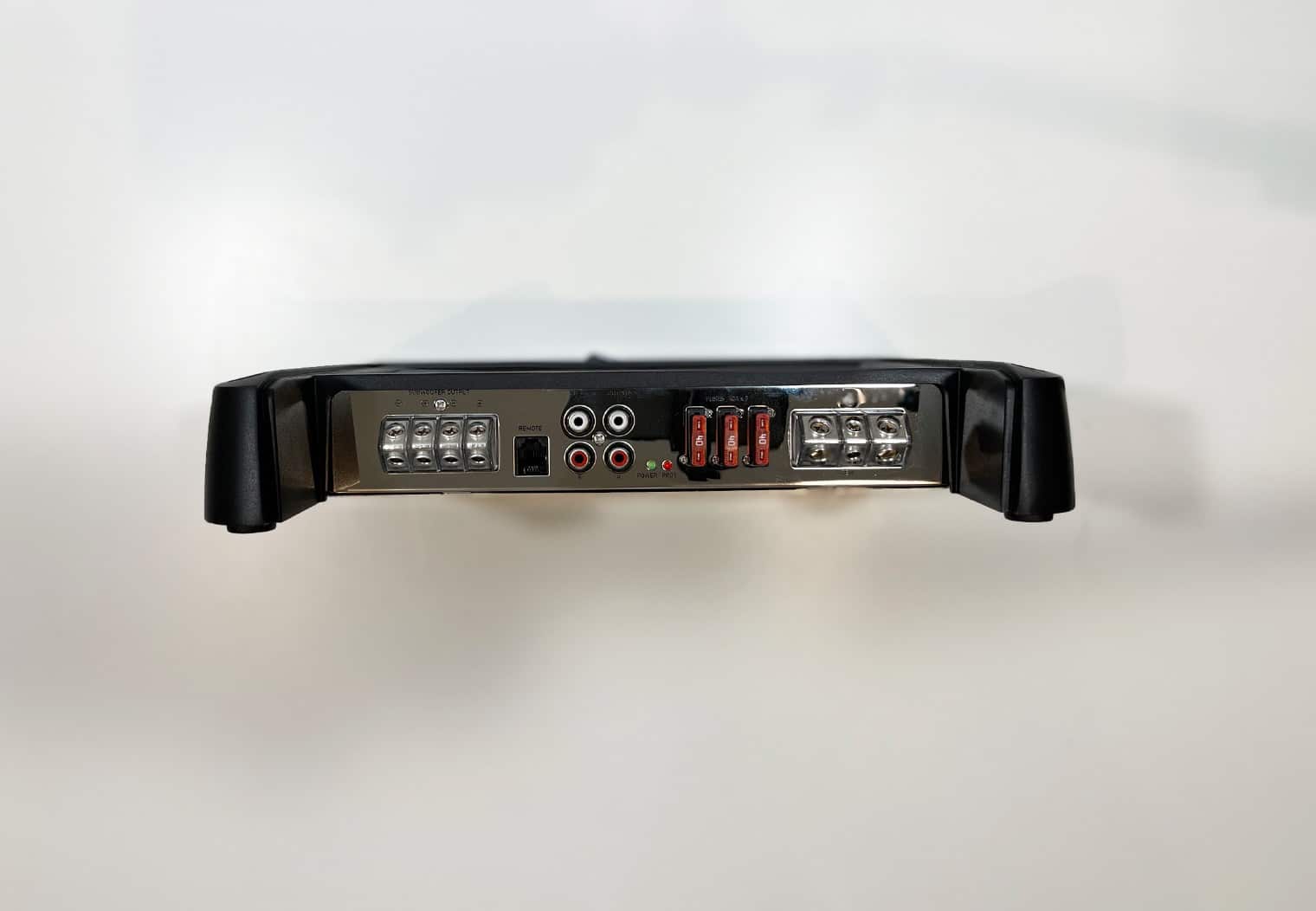
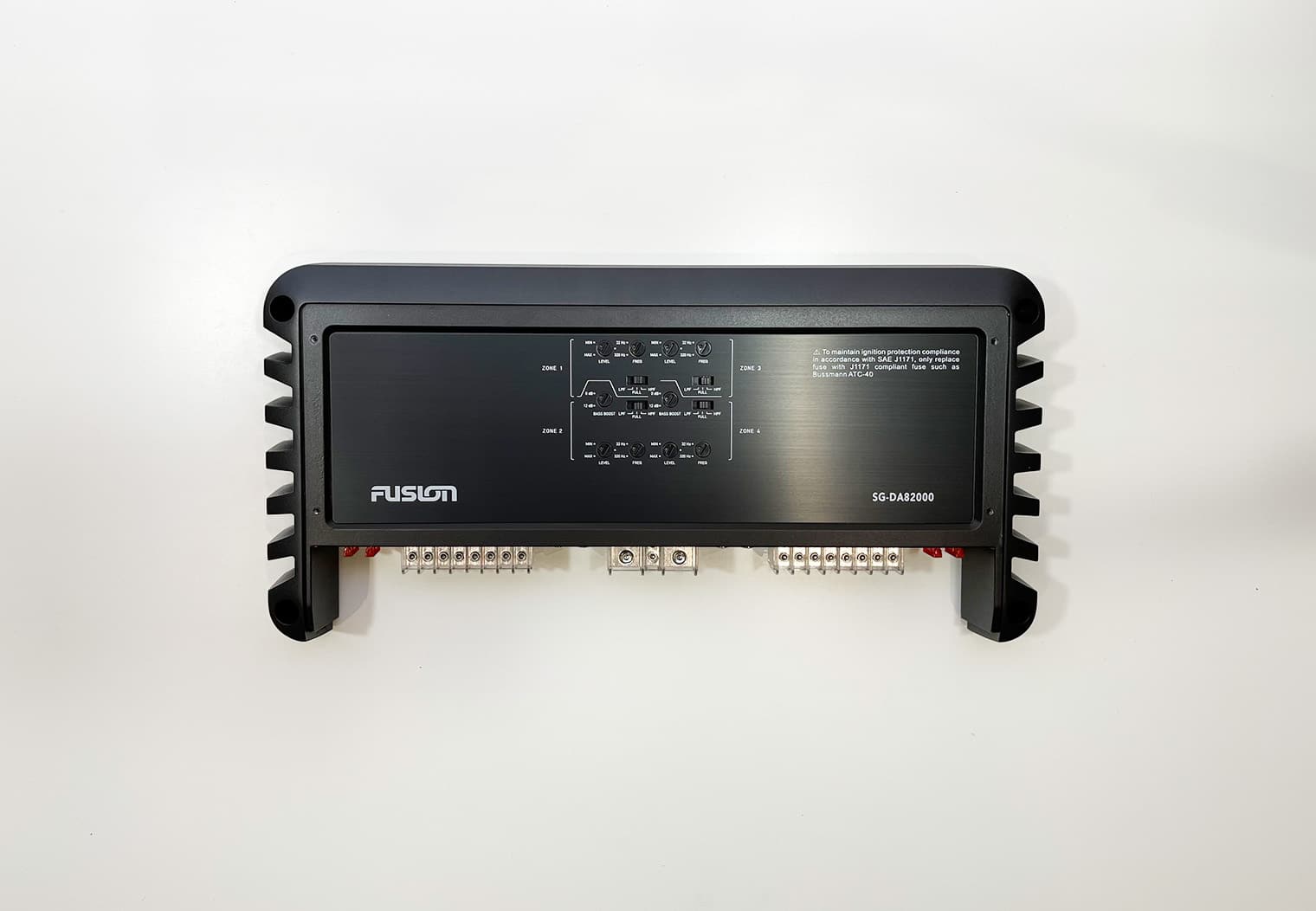
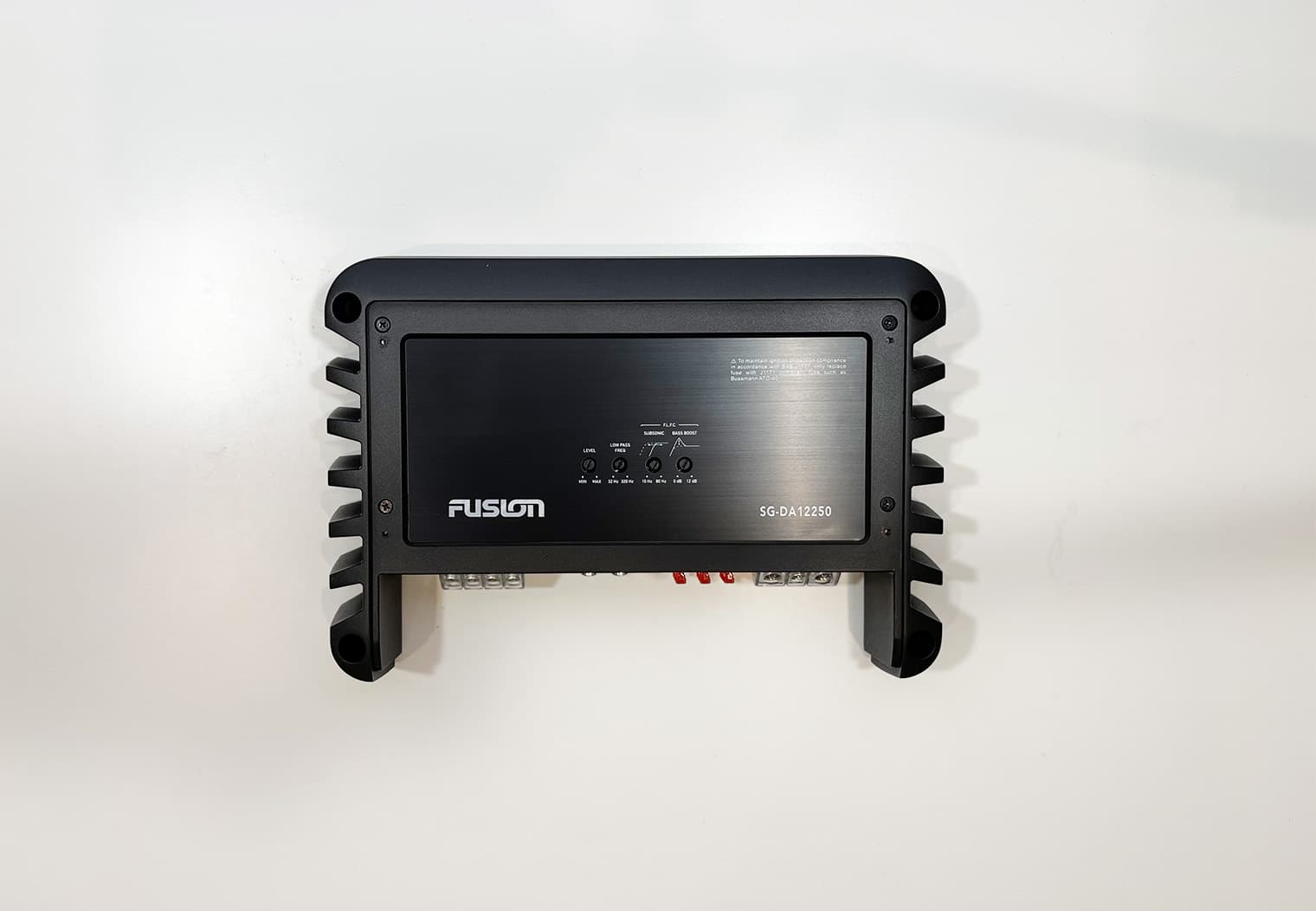
Marine-Specific Features
Let's take a quick look at some of the marine-specific features that make these amplifiers more resistant to the elements than a typical automotive amplifier.
Corrosion & Water Resistant Protection:
- Tested to a high level of protection against salt fog, temperature, vibration and UV. Not IP65 rated however.
- Stainless steel and aluminum hardware and casing. Sealed internals and water resistent construction.
- Conformal coated circuit board.
- 3-year warranty to back their products in the case that you do find corrosion somewhere!
When I looked at the amplifier, it looks well-sealed up and resistant. The conformal coated circuit board is probably the biggest feature that'll prevent corrosion directly on the board if water or moisture does enter the casing. The only thing I felt like Fusion could have done better on the water resistance features is to add a seal around the panel so that when you screw the polished stainless steel panel that covers the panel up (via 4 screws), it will seal the panel and knobs (and therefore the internals of the amplifier) better. Wet Sounds does this well with their amplifiers. The polished stainless cover just sits over the control panel without sealing it from the elements outside. Apart from that, it looks like a well-built and sealed up amplifier. Only time will tell though. If something does happen on the water as a result of corrosion I'll be sure to update this review!
Conclusion
Fusion's Signature Series amplifiers offer a wide variety of configurations with their 5 amplifiers with very impressive power output. They're a great option if you're just looking for simple power for your system, but an even better choice (no brainer in my opinion) if you're matching them up to a larger Fusion system like we were with Signature Series 3 speakers and subwoofers.
I rave about this in the MS-RA770 First Look that I did, but the zones and DSP profiles that these amps were built to align with are fantastic. I only wish that multiple zones on the amplifiers could tie to one RCA input instead of having to run separate RCAs for each zone that's in use or having to split them.
The weather proofing looks sound too. My only complaint here would be that they didn't seal up the internals completely because there's no seal around the control panel and knobs which could let moisture into the unit. However, I know that the conformal coating on the circuitboard is meant to combat this it just would have been nice to see a small rubber or other type of seal around the board.
Overall, thumbs up for these amplifiers and if you're building a Fusion system these are a must-have to match your Fusion speakers and other Fusion products.
